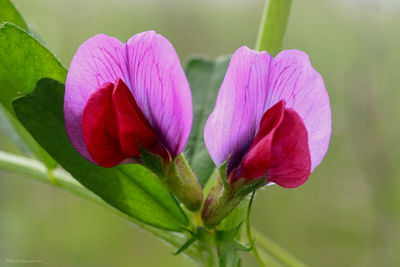Widely known as the Vicieae, the correct name for this tribe is Fabeae (see Greuter et al., 2000, Articles 19.4 and 18.5), since it must be based on the name of the type genus of the family, Faba Mill. (= Vicia L.). This does not reflect on the names Leguminosae and Papilionoideae (see introduction) whose use as alternative names for Fabaceae and Faboideae respectively is sanctioned in the International Code of Botanical Nomenclature (Greuter et al., 2000; Article 18.5).
Fabeae is a well-defined tribe, forming part of the ‘temperate epulvinate series’ (Polhill, 1981a). It contains five genera, of which two (Lathyrus and Vicia) are large. The tribe as a whole is centred in the Irano-Turanian Region of the E Mediterranean. Lathyrus and Vicia, each with about 160 species, have very similar distributions centred on the Mediterranean but extending throughout Europe, N Asia and N and tropical E Africa, with secondary centres in N America and S America. One large group of species, some in Vicia and some in Lathyrus, are superficially extremely similar and can only be distinguished by technical characters of the style. This group was in the past recognised as the genus Orobus L. (Kupicha, 1981a). Lens has 4–6 species and Pisum 2 or 3. Both include important crop plants and, perhaps because of this, their taxonomy is controversial. Both are E Mediterranean genera with outlying species. The monospecific genus Vavilovia, sometimes included in Pisum, is confined to montane habitats in W Asia.
Kupicha (1981a) was unable to suggest a closest relative of the tribe; she had previously (Kupicha, 1977) excluded Abrus (Abreae) and Cicer (Cicereae) from it. The morphological analysis of Chappill (1995) placed Fabeae (as Vicieae) in a group with Astragalinae, Galeginae, Loteae, Coronilleae, Cicereae and Trifolieae. Doyle (1995) included these subtribes and tribes (except Loteae and Coronilleae) in a clade characterised by the loss of the inverted repeat (the IRLC), with Carmichaelieae (here included in Galegeae sens. lat.), Cicereae, Galegeae, Hedysareae, some Millettieae, and Trifolieae. More recent work (Wojciechowski et al., 2000) places Fabeae at the heart of a Vicioid clade that includes Trifolieae (q.v.) and Cicereae as well as Galega — a fragment of a paraphyletic Galegeae. Fabeae (as Vicieae) appears embedded within Trifolieae as sister to Trifolium.
In the analyses of Steele & Wojciechowski (2003) and Wojciechowski et al. (2004), Fabeae (as Vicieae) forms a clearly monophyletic group in which Pisum is sister to Lathyrus, and these two emerge as a well supported clade within a paraphyletic Vicia. A subclade of Vicia species is sister to Lens. Within Lathyrus, the cpDNA restriction site phylogeny of Asmussen & Liston (1998) agrees in general with dividing the genus into sections previously recognised using classical taxonomic methodology (e.g., Kupicha, 1983).
The publications of the Vicieae Database Project (e.g., Allkin et al., 1983 a & b) provide basic information for the whole tribe. In this treatment the Fabeae is considered to comprise 5 genera and c. 329 species (Fig. 57).






